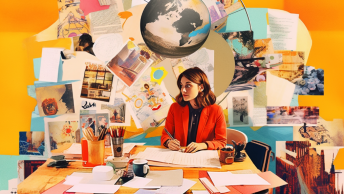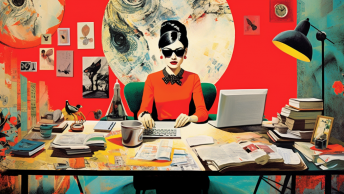Imagine being the person responsible for the artistic vision of a project or an entire company. You’re the one who ensures that the visuals, the style, and the overall aesthetic are coherent, appealing, and aligned with the project’s or company’s goals. That’s the role of an art director, a pivotal position in any organization, especially in the creative industry. And guess what? More and more women are stepping up and making a mark in this field.
The Basics: What is an Art Director?
An Art Director is a professional who maintains and enhances the artistic style and vision of a project or company. They’re the creative wizards who ensure that every visual element, from the color palette to the typography, is in harmony and serves the overall purpose of the project.
They work closely with other creatives like graphic designers, photographers, and illustrators, guiding them and making key decisions to create compelling and consistent visuals. But that’s not all. Art directors also liaise with stakeholders, including clients and marketing teams, to make sure the visual identity aligns with the brand’s image and goals.
Art Director’s Role in Different Industries
Have you ever wondered how the role of an art director varies across industries? Let’s take a brief look at this.
In advertising, an art director conceptualizes and oversees the visual aspect of ad campaigns. They work closely with copywriters to ensure that the visuals and text complement each other effectively.
In publishing, whether it’s a magazine, book, or online platform, an art director is responsible for the visual layout of pages, the cover design, and the overall aesthetic of the publication.
If we talk about film and animation, the art director plays a crucial role in creating the visual world where the story unfolds. They work on designing sets, props, and even entire animated worlds.
And in theatre, the art director, often known as the set designer, creates the physical environment where the performance takes place, contributing to the audience’s overall experience.
So, whether it’s for a product, a publication, a movie, or a play, an art director’s job is to make sure the visual elements tell a compelling story and create an engaging experience for the audience.
Skill set needed for an Art Director
What does it take to become an Art Director? It’s more than just having a knack for design. Sure, creativity is at the heart of the role, but there’s so much more to it. Let’s unpack the essential skills that an Art Director needs to thrive in the industry.
Technical Skills
First and foremost, an Art Director needs to be technically adept. This role requires an extensive understanding of various software and design tools that are crucial in bringing creative visions to life. Knowledge of Adobe Creative Suite, including Photoshop, Illustrator, and InDesign, is a must. Proficiency in 3D modeling software, video editing tools, and UX/UI design platforms can also give an Art Director an edge in the industry.
Effective Communication Skills
Have you ever considered how crucial communication is in the world of art and design? It’s easy to overlook, but the reality is that Art Directors are often the bridge between the creative team, clients, and other stakeholders. They need to effectively translate and communicate the artistic vision to ensure everyone is on the same page. This requires excellent verbal and written communication skills, as well as the ability to present ideas convincingly.
Educational Requirements for Art Directors
Now that we’ve covered the skills, let’s talk about the education. What kind of educational background do you need to become an Art Director? Generally, a bachelor’s degree in arts, design, or a related field is expected. However, it’s not just about the degree—it’s about the knowledge, expertise, and perspective you gain through your education.
- Rhode Island School of Design
- Parsons School of Design
- Pratt Institute
- University of the Arts London
- School of the Art Institute of Chicago
- California Institute of the Arts
- Royal College of Art
- Cranbrook Academy of Art
- Art Center College of Design
- Yale University School of Art
Daily Tasks of an Art Director
Ever wondered what a typical day for an art director looks like? Well, it’s quite a whirlwind! From attending planning meetings and brainstorming sessions, to collaborating with designers, photographers, writers, and marketing professionals, an art director’s workday is always bustling with activity. They are responsible not only for creating and maintaining the visual style of a project, but also for ensuring that it aligns with the overall vision and goals of the company.
It’s also not uncommon for art directors to spend time reviewing and approving designs, layouts, and other creative materials. They also often engage in constructive critique sessions to provide feedback and suggestions to their team. And let’s not forget the administrative tasks, such as budgeting and scheduling, which are crucial for keeping projects on track and within resources.
However, each day can bring a new set of tasks and challenges, depending on the specific project or campaign in focus. This is what makes the role of an art director both exciting and demanding.
Include a table showing the breakdown of an art director’s day.
| Time | Task |
|---|---|
| 8:00 AM | Review and respond to emails |
| 9:00 AM | Team Meeting |
| 10:30 AM | Project brainstorming and conceptualization |
| 1:00 PM | Lunch |
| 2:00 PM | Review project deliverables and provide feedback |
| 4:00 PM | Administrative tasks (budgeting, scheduling etc.) |
| 5:30 PM | Wrap-up meeting |
Career Path to become an Art Director
So, how does one become an Art Director? The journey often starts with a solid educational foundation in the arts or design. Many art directors start their careers in entry-level roles such as graphic designers or junior artists, where they get hands-on experience in creating and executing designs.
With time, as they gain more experience and prove their creative chops, they may get promoted to senior designer roles, where they get to lead projects and manage teams. After several years of proving their leadership and creative skills, they may finally ascend to the role of an Art Director.
However, it’s important to note that there’s no one-size-fits-all path to this role. Some art directors may take a more unconventional route, such as starting their own design firm or transitioning from a different industry. The key is to never stop learning and pushing your creative boundaries.
Pros and Cons of being an Art Director
Like any career, being an Art Director comes with its own set of rewards and challenges. On the plus side, it’s a highly creative role that allows you to shape and guide the visual direction of projects and campaigns. There’s also the satisfaction of seeing your ideas come to life and knowing that you played a crucial role in it.
In addition, it’s a leadership role that allows you to mentor and inspire other creatives, which can be incredibly rewarding. And let’s not forget the potential for recognition and prestige in the industry, especially if your work is well received.
On the flip side, the role can be quite demanding and stressful. Deadlines are often tight, and balancing creativity with practical constraints such as budget and resources can be challenging. There’s also the pressure of constantly having to come up with fresh and innovative ideas.
However, for those with a passion for creativity and leadership, the rewards of being an Art Director can far outweigh the challenges.
Salary and Job Outlook for Art Directors
Ever thought about how much an Art Director earns? It’s a question many budding creatives ask. According to the Bureau of Labor Statistics, the median annual wage for art directors was $94,220 in May 2019. The lowest 10 percent earned less than $52,160, and the highest 10 percent earned more than $184,660. Quite a range, isn’t it?
The job market for Art Directors is competitive but promising. The employment of art directors is projected to decline 2 percent from 2019 to 2029. However, the need for art directors is expected to continue in advertising, public relations, and specialized design services.
Notable Female Art Directors to Follow
Now, let’s shift our focus to some of the trailblazing women making waves in the field of art direction. Their work is inspiring, innovative, and simply breath-taking.
- Paula Scher: One of the most acclaimed graphic designers in the world, Paula is a partner at the New York office of the Pentagram design consultancy. She is known for her innovative typographic designs.
- Debbie Millman: An author, educator, brand strategist and host of the podcast Design Matters, Debbie Millman is also the co-founder and chair of the world’s first graduate program in branding at the School of Visual Arts in New York City.
- Jessica Walsh: Co-founder of the creative agency &Walsh, Jessica is recognized for her bold, playful work and for her commitment to creating a positive impact.
Climbing the Ladder: Advancement Opportunities for Art Directors
Are you wondering about the upward mobility in the field of Art Direction? The good news is, there’s plenty. Art Directors can advance to higher positions such as Creative Director, Executive Creative Director, and even Chief Creative Officer. Beyond that, many Art Directors take the entrepreneurial path and start their own design firm or creative agency. Isn’t it exciting to imagine the possibilities?
Concluding Thoughts
Art direction is not just a job, but a creative journey that demands passion, dedication, and a relentless pursuit of creative excellence. It’s a path where your creativity can truly shine and make a significant impact. Sure, it’s challenging, but isn’t it also incredibly fulfilling to see your vision come to life?
Remember, as an Art Director, your creativity can shape narratives, influence perceptions, and ultimately, leave an indelible imprint on the world. So, are you ready to start your journey?




